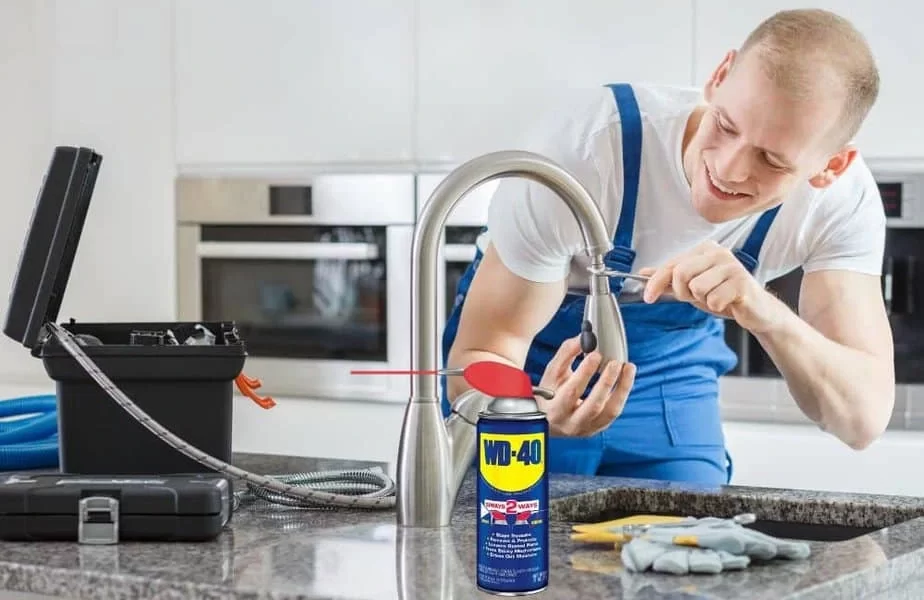WD-40, the iconic blue and yellow can found in countless households and workshops around the world, is celebrated for its versatility and ability to tackle a wide range of maintenance and DIY tasks. While most people associate WD-40 with loosening rusty bolts or silencing squeaky hinges, it may come as a surprise that this miracle lubricant can also be used to address issues with taps and faucets. In this article, we’ll explore the benefits of using WD-40 on taps, how to apply it effectively, and some important considerations to keep in mind.
Understanding Tap Issues

Taps, also known as faucets, are essential fixtures in any home or commercial setting, providing access to clean water for drinking, cooking, cleaning, and hygiene. Over time, taps may develop common issues such as stiffness, leaks, or mineral buildup, which can impede their performance and compromise water flow.
- Stiffness:
Stiff or difficult-to-turn taps are often caused by mineral deposits, corrosion, or worn internal components. This can make it challenging to adjust water temperature or shut off the tap completely.
- Leaks:
Leaky taps waste water and can lead to increased water bills, water damage, and mold growth if left unaddressed. Leaks may occur due to worn seals, damaged washers, or loose fittings.
- Mineral Buildup:
Mineral buildup, commonly known as limescale or calcium deposits, can accumulate on tap surfaces and internal components over time, restricting water flow and affecting water quality.
The Role of WD-40
WD-40’s unique formula, which combines lubricating oils with solvents, penetrants, and corrosion inhibitors, makes it an effective solution for addressing tap-related issues. Here’s how WD-40 can help:
- Lubrication:
WD-40’s lubricating properties help to reduce friction and loosen stuck or stiff tap components, such as handles, spindles, or cartridges. This makes it easier to turn the tap handles and adjust water flow without excessive force.
- Penetration:
WD-40’s penetrating formula allows it to seep into tight spaces and break down rust, corrosion, or mineral deposits that may be causing tap issues. By penetrating and loosening these deposits, WD-40 helps restore smooth operation to the tap mechanism.
- Corrosion Protection:
WD-40’s corrosion inhibitors create a protective barrier on metal surfaces, guarding against future rust and corrosion. This helps extend the lifespan of tap components and prevents deterioration due to exposure to water and environmental factors.
How to Use WD-40 on Taps
Using WD-40 to address tap issues is a straightforward process that requires minimal tools and expertise. Here’s a step-by-step guide to using WD-40 on taps effectively:
- Preparation:
Before applying WD-40, turn off the water supply to the tap and remove any decorative caps or covers to access the tap mechanism. Use a wrench or pliers to loosen and remove the tap handle, exposing the internal components.
- Cleaning:
Inspect the tap components for any visible signs of corrosion, mineral buildup, or damage. Use a soft brush, sponge, or cloth to remove dirt, grime, and debris from the tap surfaces. For stubborn deposits, you may need to soak the components in a solution of vinegar and water to dissolve mineral buildup.
- Application:
Spray WD-40 directly onto the tap components, focusing on areas with visible corrosion, mineral deposits, or stiffness. Allow the WD-40 to penetrate for a few minutes, then use a cloth or brush to gently scrub the affected areas. Repeat the process as needed until the tap mechanism moves freely and smoothly.
- Reassembly:
Once the tap components have been lubricated and cleaned, reassemble the tap in the reverse order of disassembly. Tighten the tap handle securely and replace any decorative caps or covers. Turn on the water supply and test the tap to ensure that it operates smoothly and without leaks.
Important Considerations
While WD-40 can be an effective solution for addressing tap issues, there are some important considerations to keep in mind:
- Compatibility:
WD-40 is safe to use on most metal surfaces, including brass, copper, stainless steel, and chrome-plated finishes. However, it may not be suitable for certain materials, such as plastic or rubber components found in some tap assemblies. Always check the manufacturer’s recommendations and test a small, inconspicuous area before applying WD-40 to ensure compatibility.
- Ventilation:
When using WD-40 in enclosed or poorly ventilated spaces, ensure adequate ventilation to avoid inhaling fumes or vapors. Open windows or doors, use fans, and wear appropriate personal protective equipment, such as gloves and a respirator, if necessary.
- Safety:
Exercise caution when working with tap components, especially if using tools or applying excessive force. Avoid over-tightening fittings or using abrasive materials that could damage the tap surfaces. If you encounter any issues beyond your expertise, consult a qualified plumber or technician for professional assistance.




